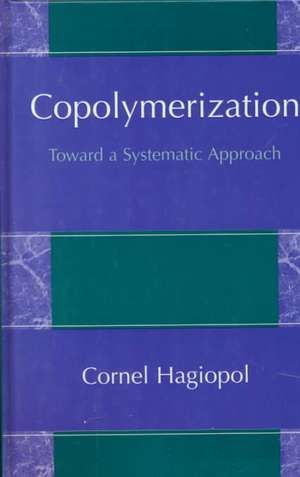Copolymerization: Toward a Systematic Approach
Autor Cornel Hagiopolen Limba Engleză Mixed media product – 31 ian 2000
Preț: 421.80 lei
Preț vechi: 458.47 lei
-8% Nou
Puncte Express: 633
Preț estimativ în valută:
80.71€ • 84.27$ • 66.80£
80.71€ • 84.27$ • 66.80£
Carte indisponibilă temporar
Doresc să fiu notificat când acest titlu va fi disponibil:
Se trimite...
Preluare comenzi: 021 569.72.76
Specificații
ISBN-13: 9780306461798
ISBN-10: 030646179X
Pagini: 228
Ilustrații: XI, 228 p. With CD-ROM.
Dimensiuni: 155 x 235 x 14 mm
Greutate: 0.52 kg
Ediția:1999
Editura: Springer Us
Colecția Springer
Locul publicării:New York, NY, United States
ISBN-10: 030646179X
Pagini: 228
Ilustrații: XI, 228 p. With CD-ROM.
Dimensiuni: 155 x 235 x 14 mm
Greutate: 0.52 kg
Ediția:1999
Editura: Springer Us
Colecția Springer
Locul publicării:New York, NY, United States
Public țintă
ResearchCuprins
1. Binary Copolymerization.- 1.1. Copolymers and Copolymerization Processes.- 1.2. The Terminal Kinetic Model: The Copolymer Composition Equation.- 1.3. Copolymerization Reaction Types.- 1.4. The Integral Form of the Copolymerization Equation.- 1.5. Use of the Differential and Integral Forms of the Mayo—Lewis Equation to Describe Copolymerization Processes.- 2. Estimation of Reactivity Ratios.- 2.1. Analysis of Experimental Data.- 2.2. How Consistent Are Existing Reactivity Ratios?.- 2.3. Differential Methods for Calculating Reactivity Ratios.- 2.4. Preliminary Remarks on an Experimental Strategy for Estimating Reactivity Ratios.- 2.5. Shortcomings of Differential Methods when Conversion Is Taken into Account.- 2.6. Estimation of Reactivity Ratios when Conversion Values Are Taken into Account.- 2.7. The Use of Composition versus Conversion Data in Estimating Reactivity Ratios.- 2.8. Recalculated Values for Reactivity Ratios.- 2.9. Experimental Errors and Effectiveness of theQ—eScheme.- 3. Ternary Copolymerization.- 3.1. The Terminal Kinetic Model: The Alfrey—Goldfinger Equation..- 3.2. Estimation of Reactivity Ratios Directly from Ternary Copolymerization Data.- 3.3. Azeotropy with Ternary Copolymerization.- 3.4. Consistency of Reactivity Ratio Values Used in Ternary Copolymerization.- 3.5. Do Ternary Azeotropes Exist? (Pseudoazeotropy).- 4. Going Beyond the Limits of the Terminal Model.- 4.1. The Extent to Which the Mayo—Lewis Equation Can Fit All Copolymerization Data.- 4.2. Higher Order Kinetic Models.- 4.3. The Potential of Experimental Composition Data.- 4.4. Optimal Experimental Design for Estimating Reactivity Ratios.- 4.5. Model Discrimination.- 4.6. Generalized Kinetic Model for Binary Copolymerization.- 5. Homogeneous and HeterogeneousCopolymerization.- 5.1. Copolymerization within Initially Homogeneous Systems.- 5.2. Emulsion Copolymerization.- 5.3. Copolymer Composition and the Mechanism of Emulsion Copolymerization.- 6. Running a Copolymerization Process.
